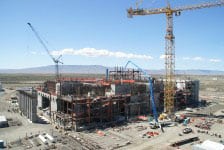
SUMMERLIN, Nev. — The Energy Department’s Office of Environmental Management (EM) is establishing a new unit that will focus on completing the Hanford Site’s Waste Treatment Plant, Roger Jarrell, senior adviser to the secretary of energy for environmental management, said Tuesday.
Efforts are being made to streamline management decisions at EM, a roughly $6 billion-per-year office that oversees cleanup of DOE’s nuclear legacy, Jarrell said during the ExchangeMonitor’s RadWaste Summit.
Jarrell cited the 45-day review of EM operations that is being led by acting Assistant Energy Secretary for Environmental Management James Owendoff. More will be revealed on the outcome of the assessment in the near future, Jarrell said.
The review is intended to enable DOE to better concentrate resources on some of its more complex challenges. The department wants increased management attention and a “laser-like focus” on those matters, Jarrell said.
Toward this end, a new office of special projects is being created within EM. It will be led by longtime DOE hand Dae Chung, who will focus on the Waste Treatment Plant, Jarrell said. The new office should help get Hanford tank waste treatment up and running, he added.
“This is one of the highest priorities going forward and we want to bring as many resources to bear as possible. We want to beat the deadline,” Jarrell said.
DOE officials contacted by Weapons Complex Monitor could not immediately offer additional detail regarding the unit, including staffing and operations.
The Waste Treatment Plant is being built at the Hanford Site in Washington state to treat up to 56 million gallons of chemical and radioactive waste left over from decades of plutonium production for the U.S. nuclear deterrent.
The plant must legally begin treating Hanford’s briny, less-radioactive low-level waste by 2023, though construction prime Bechtel National would forfeit millions of dollars in fees if processing does not begin in 2022.
Under a federal court order, full operations of the WTP must begin by the end of 2036.
The key thing “is to start making glass,” Jarrell said. The Waste Treatment Plant will convert the waste into a glass form for storage, a process known as vitrification.
Energy Secretary Rick Perry met a few weeks ago with officials from Bechtel, Jarrell noted.
As originally envisioned, the Hanford “vit plant” would treat high-level and low-activity radioactive waste simultaneously. At one point, DOE and Bechtel thought WTP would begin treating both high-level and low-activity waste around 2020. However, the agency halted much of the work on WTP’s high-level waste facilities in 2012 after a whistleblower at a Bechtel subcontractor raised safety concerns about the proposed technical approach for high-level waste treatment.
The Energy Department is now pursuing a revised approach that would treat low-activity waste first within a handful of years, called direct feed low-activity waste, or DFLAW.
Chung has over 28 years of combined experience in the U.S. government and commercial nuclear industries, according to his DOE biography. He held a number of senior positions at the department over 24 years, including principal deputy assistant secretary for environmental management. Prior to rejoining DOE in July, he was a senior executive vice president for Samsung C&T Corp.